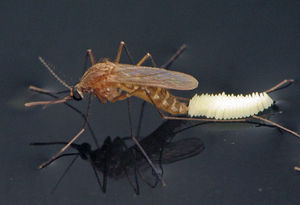Culicidae

Author(s): Sean McCann
Source: Flickr
| Vernacular names | |
|---|---|
| • Deutsch: | Stechmücken |
| • English: | mosquitoes |
| • Español: | mosquitos culícidos |
| • Français: | moustiques |
Culicidae - (mosquitoes)
The family includes several thousand species and is represented in all parts of the world. Many species are well known blood-sucking nuisance pests and important vectors of human and animal diseases. Culicidae are characterized by their long proboscis and long antennae. Their body and wings are covered with minute scales. They are not good fliers and fly short distances only.
Females need to take a blood meal before being able to lay eggs. Exceptions are a few species which have predatory larval stages, e.g. the larvae of the genus Toxorhynchites feed on other mosquito larvae and the adults of both sexes feed on nectar only.
The adult is usually less than 10 mm long. Males can be recognized by the bushy antennae. They also have a proboscis but do not bite and feed mainly on nectar. Males often form swarms which attract females and copulation occurs inside the swarm.
The larval stages live in stagnant water and common breeding sites are ponds, swamps, temporary water accumulations and discarded containers filled with water. Depending on the species, the water may be polluted and even brackish. Most species filter microorganisms and organic particles out of the water with their mouthparts and feed on them.
The following genera are currently entered under Culicidae:
